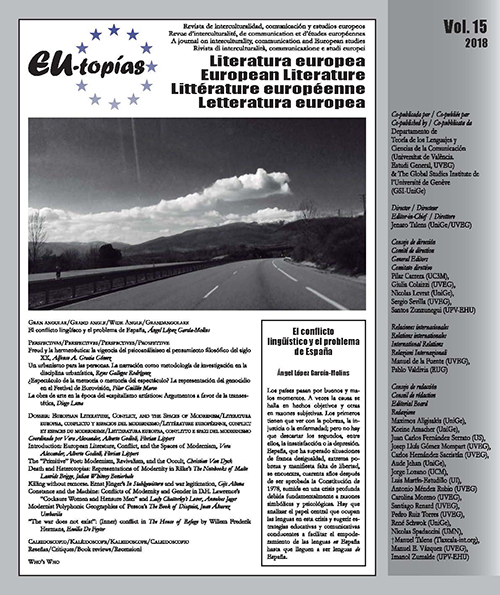Death and Heterotopias: Representations of Modernity in Rilke’s The Notebooks of Malte Laurids Brigge
DOI:
https://doi.org/10.7203/eutopias.0.18578Keywords:
Rilke, Foucault, death, heterotopia Abstract
Abstract
This essay explores the thematization of death and modernity in Rilke’s The Notebooks of Malte Laurids Brigge through a framework of Michel Foucault’s concept of heterotopia. Described as spaces that are simultaneously mythic and real, heterotopias are special spaces embedded with more than one apparent layer of meaning. The special qualities of heterotopias open up a space that is not bound by normal laws of geometry and instead becomes an intersection or point of view between the mythic and real. This essay’s main focus is on an integrative examination of scenes from The Notebooks of Malte Laurids Brigge and Foucault’s concept of heterotopia. After outlining the overlap between the prevalence of images of death strewn throughout the novel and the cultural pressure exerted by modernity on the metropolis, I suggest that it is possible to understand the protagonist’s quest for self-realization by examining his encounters with diverse heterotopic spaces.
 Downloads
Downloads
 References
References
Baudelaire, Charles (1954), The Flowers of Evil, translated by William Aggeler, Fresno, CA: Academy Library Guild.
Berman, Marshall (2010), All That Is Solid Melts into Air: The Experience of Modernity, London: Verso.
Donahue, Neil H. (1992), “Fear and Fascination in the Big City: Rilke’s Use of Georg Simmel in ‘The Notebooks of Malte Laurids Brigge’”, Studies in 20th and 21st Century Literature, 16, 2, pp. 197-219.
Eiland, Howard, & Jennings, Michael W. (2016), Walter Benjamin: a Critical Life, Boston: Belknap Press of Harvard University.
Foucault, Michel (1986), “Of Other Spaces: Utopias and Heterotopias”, translated by Jay Miskowiec, Diacritics, 16, 1, pp. 22-27.
Hetherington, Kevin (1997), The Badlands of Modernity: Heterotopia and Social Ordering, London and New York: Routledge.
Garber, Frederick (1970), “Time and the City in Rilke’s ‘Malte Laurids Brigge’”. Contemporary Literature, 11, 3, pp. 324-39.
Gregg , John (1988), “Blanchot’s Suicidal Artist: Writing and the (Im)Possibility of Death”, SubStance, 17, 1, 55, pp. 47-58.
Jervis, John (1998), Exploring the Modern: Patterns of Western Culture and Civilization, Oxford: Blackwell.
Marder, Elissa (2001), Dead Time: Temporal Disorders in the Wake of Modernity (Baudelaire and Flaubert), Stanford, CA: Stanford University Press.
Nietzsche, Friedrich (1980), On the Advantage and Disadvantage of History for Life, translated by Peter Preuss, Indianapolis and Cambridge: Hackett Publishing.
Orlando, Francesco (2006), Obsolete Objects in the Literary Imagination: Ruins, Relics, Rarities, Rubbish, Uninhabited Places, and Hidden Treasures, Connecticut: Yale
University Press.
Radford, Gary P., Radford, Marie L. & Lingel, Jessica (2015), “The library as heterotopia: Michel Foucault and the experience of library space”, Journal of Documentation, 71, 4, pp. 733-751.
Rilke, Rainer Maria & Andreas-Salomé, Lou (2014), Rilke and Andreas-Salomé: A Love Story in Letters, translated by Edward Snow and Michael Winter, New York: W. W. Norton & Company.
Rilke, Rainer Maria (2009), The Notebooks of Malte Laurids Brigge, translated by Michael Hulse, London: Penguin Classics.
Simmel, Georg (1971), On Individuality and Social Forms: Selected Writings, edited by Donald N. Levine, Chicago:University of Chicago Press.
Downloads
Published
How to Cite
-
Abstract306
-
PDF110
Issue
Section
License
![]()
The authors conserve the copyright. All content published in EU-topías. Journal of interculturality, Communication, and European Studies are subject to the license Creative Commons Attribution-NonCommercial-ShareAlike 4.0 license. The full text of the license can be found at <http://creativecommons.org/licenses/by-nc-sa/4.0>
They may be copied, used, disseminated, transmitted and publicly displayed, provided that:
- The authorship and original source of the publication is cited (journal, publisher and URL of the work).
- They are not used for commercial purposes.
- The existence and specifications of this license of use are mentioned.
It is the responsibility of the authors to obtain the necessary permissions for images that are subject to copyright.



